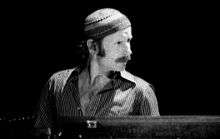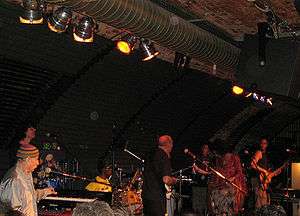Joe Zawinul
| Joe Zawinul | |
|---|---|
|
Joe Zawinul with the Zawinul Syndicate (Freiburg, Germany, 2007) | |
| Background information | |
| Birth name | Josef Erich Zawinul |
| Born |
July 7, 1932 Vienna, Austria |
| Died |
September 11, 2007 (aged 75) Vienna |
| Genres | Jazz, jazz fusion, world |
| Occupation(s) | Musician |
| Instruments | keyboards, percussion, drums, guitar |
| Years active | 1949–2007 |
| Labels | Columbia, ESC |
| Associated acts | Cannonball Adderley, Nat Adderley, Miles Davis, Weather Report, Zawinul Syndicate |
| Website |
www |
Josef Erich "Joe" Zawinul (July 7, 1932 – September 11, 2007)[1] was an Austrian jazz keyboardist and composer.
First coming to prominence with saxophonist Cannonball Adderley, Zawinul went on to play with trumpeter Miles Davis, and to become one of the creators of jazz fusion, an innovative musical genre that combined jazz with elements of rock and world music. Later, he co-founded the groups Weather Report and the Zawinul Syndicate. He pioneered the use of electric piano and synthesizer, and was named "Best Electric Keyboardist" twenty-eight times by the readers of Down Beat magazine.[2] Zawinul's playing style was often dominated by quirky melodic improvisations – traversing bebop, ethnic and pop styles – combined with sparse but rhythmic playing of big-band sounding chords or bass lines. In Weather Report, he often employed a vocoder as well as pre-recorded sounds played (i.e. filtered and transposed) through a synthesizer, a method or technique called sampling, creating a very distinctive synthesis of jazz harmonies and "noise" ("using all the sounds the world generates").
A number of prominent musical artists have honored Zawinul with compositions, including Brian Eno's instrumental "Zawinul/Lava", John McLaughlin's instrumental "Jozy", Warren Cuccurullo's "Hey Zawinul", Bob Baldwin's "Joe Zawinul", Chucho Valdés's "Zawinul's Mambo", Biréli Lagrène's instrumental "Josef" and Toninho Horta's instrumental "Balada para Zawinul".
Biography
Early life and career
Zawinul was born and grew up in Landstraße, as a son of the worker Josef Zawinul, in Vienna, Austria, where he went to school with Thomas Klestil, who became Austrian Federal President. His grandmother was a Hungarian Sintesa ("Gypsy"), and his grandfather was from southern Moravia.
Classically trained at the Konservatorium Wien, Zawinul played in various broadcasting and studio bands before emigrating to the U.S. in 1959 on a music scholarship at Berklee School of Music in Boston.
He went on to play with trumpeter Maynard Ferguson, where he first met Wayne Shorter after having had an influence in hiring him. Shorter left soon thereafter to play in Art Blakey's group and Zawinul was apparently dismissed from the Ferguson band for wanting too much control over personnel decisions. Zawinul then toured and recorded with singer Dinah Washington from 1959 to 1961.[3]
With Cannonball Adderley
In 1961, Zawinul joined the Quintet led by saxophonist Cannonball Adderley.[1] During his nine-year stint with Adderley, he wrote the hit song "Mercy, Mercy, Mercy". He also composed "Walk Tall" and "Country Preacher", the latter a tribute to the American Civil Rights Movement leader Jesse Jackson, from the 1969 Country Preacher album.
With Miles Davis
In the late 1960s, Zawinul recorded with Miles Davis's studio band and helped create the sound of jazz fusion. He played on the album In a Silent Way, the title track of which he composed, and the landmark album Bitches Brew, for which he contributed the twenty-minute track "Pharaoh's Dance", which occupied the whole of side one.[1]
Zawinul is known to have played live with Davis only once, on July 10, 1991, in Paris, along with Wayne Shorter, shortly before Davis' death.[1]
Zawinul, along with other Davis sidemen Chick Corea and Herbie Hancock, was one of the first to use electric pianos and early synthesizers like the ARP 2600 in 1973's Sweetnighter. He was also among the first to use an electric piano, the Wurlitzer. He used the Fender-Rhodes thereafter, adding a wah-wah pedal and later the Mutron effect unit for a complex phased timbre. His creativity and attention to detail resulted in a very modern sound. He also played the kalimba on Weather Report's albums Mysterious Traveller and Mr. Gone.
With Weather Report
In 1970, Zawinul co-founded Weather Report with saxophonist and Davis alumnus Wayne Shorter. Their first two years emphasized a relatively open, group improvisation format not dissimilar to what Miles Davis was doing in a more rock oriented format. However, Zawinul started making changes with their third album, Sweetnighter, stating that he was "tired of waiting for something to happen". Funk elements such as electric bass, wah-wah pedal, etc. began to be introduced to the band's sound. With their 4th album, Mysterious Traveller, the musical forms were now through-composed similar to classical music, and the combination of jazz harmonies with 1970s groove elements helped launch the band into its most commercially successful period.

The band's biggest commercial success came from his composition "Birdland", a 6-minute opus featured on Weather Report's 1977 album Heavy Weather, which peaked at number 30 on the Billboard pop albums chart. "Birdland" is one of the most recognizable jazz pieces of the 1970s, covered by many prominent artists from The Manhattan Transfer and Quincy Jones to Maynard Ferguson, the Buddy Rich Big Band, and Jefferson Starship. Even Weather Report's version received significant mainstream radio airplay – unusual for them – and served to convert many new fans to music which they may never have heard otherwise. The song won him three Grammys.
Weather Report was active until the mid-1980s, with Zawinul and Shorter remaining the sole constant members through multiple personnel shifts. The group was notable for helping bring to prominence not only pioneering fretless electric bassist Jaco Pastorius, but also other musicians, such as Alphonso Johnson and Peter Erskine. Shorter and Zawinul had already gone separate ways, after the recording of their "final" Sportin' Life, when it was discovered that they had to do one more album in order to fulfill their contract with CBS records. This Is This! therefore became the band's final album. Shorter participated despite being busy leading his own group, and Peter Erskine was also brought in again for this record, and played on most of the compositions. Victor Bailey played electric bass and guitarist Carlos Santana appeared as a guest artist on the album.
With Absolute Ensemble
Absolute Zawinul, a CD recording by Absolute Ensemble, with music by Zawinul, is the last studio recording done during the year that Zawinul died in 2007, and features some of his original music as well as orchestrations by Absolute Ensemble member, Gene Pritsker, which he created in collaboration with Zawinul.
Later career
Zawinul also wrote a symphony, called Stories of the Danube, which was commissioned by the Brucknerhaus, Linz. It was first performed as part of the Linzer Klangwolke (a large-scale open-air broadcast event), for the opening of the 1993 Bruckner Festival in Linz. In its seven movements, the symphony traces the course of the Danube from Donaueschingen through various countries ending at the Black Sea. It was recorded in 1995 by the Czech State Philharmonic Orchestra, Brno, conducted by Caspar Richter.
Death
Zawinul became ill and was hospitalized in his native Vienna on August 7, 2007,[4] after concluding a five-week European tour. He died a little over a month later from a rare form of skin cancer (Merkel cell carcinoma) on September 11, 2007.[5][6] He is buried in the Zentralfriedhof Cemetery in Vienna.
Discography

As leader
- To You with Love (Strand, 1959)
- Money in the Pocket (Atlantic, 1966)
- The Rise and Fall of the Third Stream (Vortex, 1968)
- Zawinul (Atlantic, 1971)
- Di•a•lects (Columbia, 1986)
- The Immigrants (Columbia, 1988)
- Black Water (Columbia, 1989)
- Lost Tribes (Columbia, 1992)
- My People (ESC, 1996)
- Stories of the Danube (Polygram, 1996)
- World Tour (ESC, 1997)
- Mauthausen - Vom großen Sterben hören (ESC, 2000)
- Faces & Places (ESC, 2002)
- Joe Zawinul & The Zawinul Syndicate – Vienna Nights – Live at Joe Zawinul's Birdland (BirdJAM, 2005)
- Brown Street (2006)
- 75 (BirdJAM, 2008)
With
- Music for Two Pianos (Capriccio, 2006) with the WDR Big Band
- Weather Report (Columbia, 1971)
- I Sing the Body Electric (Columbia, 1972)
- Live in Tokyo (Columbia, 1972)
- Sweetnighter (Columbia, 1973)
- Mysterious Traveller (1974)
- Tale Spinnin' (1975)
- Black Market (1976)
- Heavy Weather (1977)
- Mr. Gone (1978)
- 8:30 (1979)
- Night Passage (1980)
- Weather Report (1982)
- Procession (1983)
- Domino Theory (1984)
- Sportin' Life (1985)
- This Is This! (1986)
- Live and Unreleased (2002)
- Forecast: Tomorrow (2006)
Absolute Ensemble
- Absolute Zawinul (2010)
As sideman
With Dinah Washington
- What a Diff'rence a Day Makes! (Mercury, 1960)
- The Two of Us (Mercury, 1960)
With Cannonball Adderley
- Nancy Wilson/Cannonball Adderley (Capitol, 1961)
- The Cannonball Adderley Sextet in New York (Riverside, 1962)
- Cannonball in Europe! (Riverside, 1962)
- Jazz Workshop Revisited (Riverside, 1963)
- Autumn Leaves (Riverside [Japan], 1963)
- Nippon Soul (Riverside, 1963)
- Cannonball Adderley Live! (Capitol, 1964)
- Live Session! (Capitol, 1964)
- Cannonball Adderley's Fiddler on the Roof (Capitol, 1964)
- Domination (Capitol, 1965)
- Money in the Pocket (Capitol, 1966)
- Great Love Themes (Capitol, 1966)
- Mercy, Mercy, Mercy! Live at 'The Club' (Capitol, 1966)
- Cannonball in Japan (Capitol, 1966)
- Radio Nights (Night, 1967-8)
- 74 Miles Away (Capitol, 1967)
- Why Am I Treated So Bad! (Capitol, 1967)
- Accent on Africa (Capitol, 1968)
- Country Preacher (Capitol, 1969)
- In Person (Capitol, 1970)
- The Cannonball Adderley Quintet & Orchestra (Capitol, 1970)
- The Price You Got to Pay to Be Free (Capitol, 1970)
With Nat Adderley
- Naturally! (Jazzland, 1961)
- Autobiography (Atlantic, 1964)
- Live at Memory Lane (Atlantic, 1966)
- The Scavenger (Milestone, 1968)
- You, Baby (CTI, 1968)
- Calling Out Loud (CTI, 1968)
With Miles Davis
- In a Silent Way (Columbia, 1969)
- Big Fun (Columbia, 1969)
- Bitches Brew (Columbia, 1970)
- Live-Evil (Columbia, 1971)
- Circle in the Round (Columbia, 1979)
With Victor Feldman
- Soviet Jazz Themes (Äva, 1962)
With Jimmy Forrest
- Out of the Forrest (Prestige, 1961)
With Eddie Harris
- Silver Cycles (Atlantic, 1968)
With Sam Jones
- Down Home (Riverside, 1962)
With Yusef Lateef
- The Centaur and the Phoenix (Riverside, 1960)
- Suite 16 (Atlantic, 1970)
With Herbie Mann
- A Mann & A Woman (Atlantic, 1966) with Tamiko Jones
- The Beat Goes On (Atlantic, 1967)
- The Many Facets of David Newman (Atlantic, 1969)
As contributor
- Amen by Salif Keita (Mango, 1991)
- Crazy Saints by Trilok Gurtu (1993)
References
- 1 2 3 4 Richard S. Ginell. "Joe Zawinul | Biography & History". AllMusic. Retrieved 2016-01-11.
- ↑ Archived February 11, 2010, at the Wayback Machine.
- ↑ "Zawinul, Joe". Encyclopedia of World Biography, v. 28 (2nd ed.). Detroit: Gale. 2008. p. 389.391. ISBN 9780787622213.
- ↑ Curt Bianchi (2007-08-07). "Blog Archive » Joe Zawinul Hospitalized in Vienna". Zawinulonline.org. Retrieved 2016-01-11.
- ↑ McDonald, Ray (September 12, 2007). "Keyboardist Joe Zawinul Dies". VOA News. Voice of America. Retrieved January 2, 2009.
- ↑ Schudel, Matt (September 12, 2007). "Joe Zawinul, 75; Keyboardist Was a Pioneer of Jazz Fusion". The Washington Post. Retrieved May 6, 2010.
Biographies
- Glasser, Brian (2001). In a Silent Way: A Portrait of Joe Zawinul. London: Sanctuary. ISBN 1-86074-326-9. OCLC 45900631.
- Baumann, Gunther (2002). Zawinul: Ein Leben aus Jazz [Zawinul: A Life of Jazz] (in German). Salzburg; Wien: Frankfurt am Main; Residenz. ISBN 3-7017-1291-3. OCLC 469270497.
- Yamashita, Kunihiko (2006). Joe Zawinul: On the Creative Process. Tokyo: Rittor Music. ISBN 4-8456-1337-9. OCLC 169983180.
External links
| Wikimedia Commons has media related to Joe Zawinul. |
